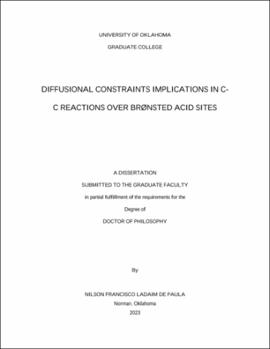| dc.description.abstract | The constrained pore structure and catalytic properties of zeolites can occasionally offer diffusion limitations to a molecule during the course of a chemical reaction. These constraints significantly impact the rate of condensation or cracking, either as a result of the spatial conformation of the reacting molecule inside a confined domain or the high catalytic activity of a reacting site. It is proposed an experimental approach to conveniently control the concentration of acid sites in commercial zeolite samples using the exchange property of that active proton and an alkaline atom such as sodium (Na). By combining this approach with reaction-diffusion modeling, one can measure the extent of mass-transfer limitations (MTL) in different catalytic systems and analyze the change in product selectivity or rate profile as the governing regime changes. In the case of comparing the structural differences between reactants such as acetone and cyclopentanone in restrained environments, a notable impact was observed due to the larger volume of the molecule. As the space voids increase from one constrained zeolite topology to a more accessible structure, a lower degree of mass-transfer limitations is detected. However, for the smaller reacting particle could access hindered sites as compared to the larger reactant, resulting in a higher consumption rate and notable mass-transfer limitations relative to site activity rather than spatial restraints. Instead of deactivating a site prior to the catalytic reaction, it is also investigated the in-situ addition of an inert-poison specie. While alkaline-exchange was relatively effective in quantitatively determining the extent of MTL, in-situ additions were successful in qualitatively controlling the governing regime properties and affecting the product distribution as a consequence. The structural similarities between the solvent and the titrant molecule resulted in a certain degree of desorption, which was inadequate for ascertaining the concentration of acid sites, as observed in literature.
To conveniently control the particle size through zeolite synthesis, one can also acknowledge the effect of diffusion on reaction rate. This particle presented an agglomeration of nanoaggregates over the outer surface of a big unchanged particle, in which occurred to considerably contribute towards the catalytic activity. Na-titration was able to identify mass-transfer limitations in the most active sample, but it was limited in explaining the activity reduction for the larger nanoparticle size sample.
While controlling the concentration of acid sites was proven experimentally to diminish the influence of mass-transfer limitations, the presence of mesoporosity is also another experimental route towards decrease such limitations and it is investigated here for the commercial samples of zeolite Y. The parent form of zeolite Y presented a certain degree of diffusion restraint, but as mesoporous channels were introduced, a boost in activity occurred for hydrocarbon cracking, probably through an exposure of synergistic sites. These were assumed to be either sites located in more active environments or proximate enough to contribute to a higher catalytic rate. Na-titration was adequate in identifying their contribution in activity in mesoporous samples, and decreasing the Bronsted acid density also supports the idea that proximate sites were contributing to the higher catalytic activity. By using different titrant cations, preferential titration over those synergistic sites occurred in all cases, being more effective as a bivalent cation addition. The mechanistic discussion of whether those sites favored cracking via protonation of a saturated or unsaturated hydrocarbon was performed, showing the inverse correlation between the reaction pathways rather than specific features of a catalyst only.
The results reveal the complex interplay between the reaction kinetics, diffusion limitations, and product selectivity, and provide insights into how to optimize zeolite catalysts for different applications. Overall, this work contributes to a better understanding of the fundamental mechanisms governing diffusion limitations in zeolites and provides a feasible experimental approach to more efficient design and selective processes results, being controlling the extent of mass-transfer limitations or restricting a site functioning that favors a specific reaction route. | en_US |
